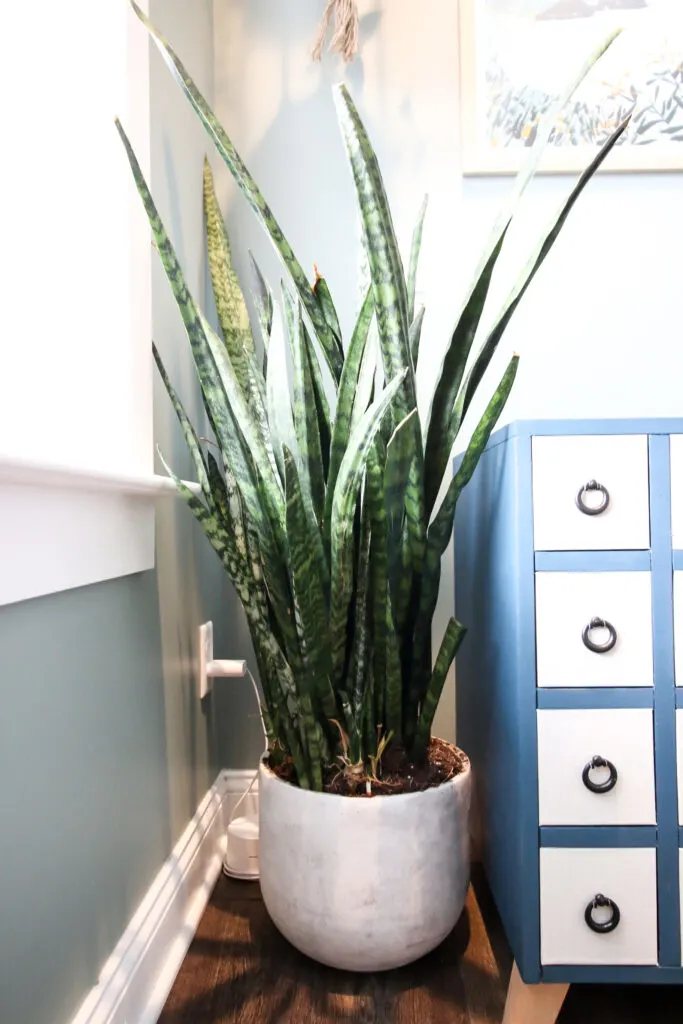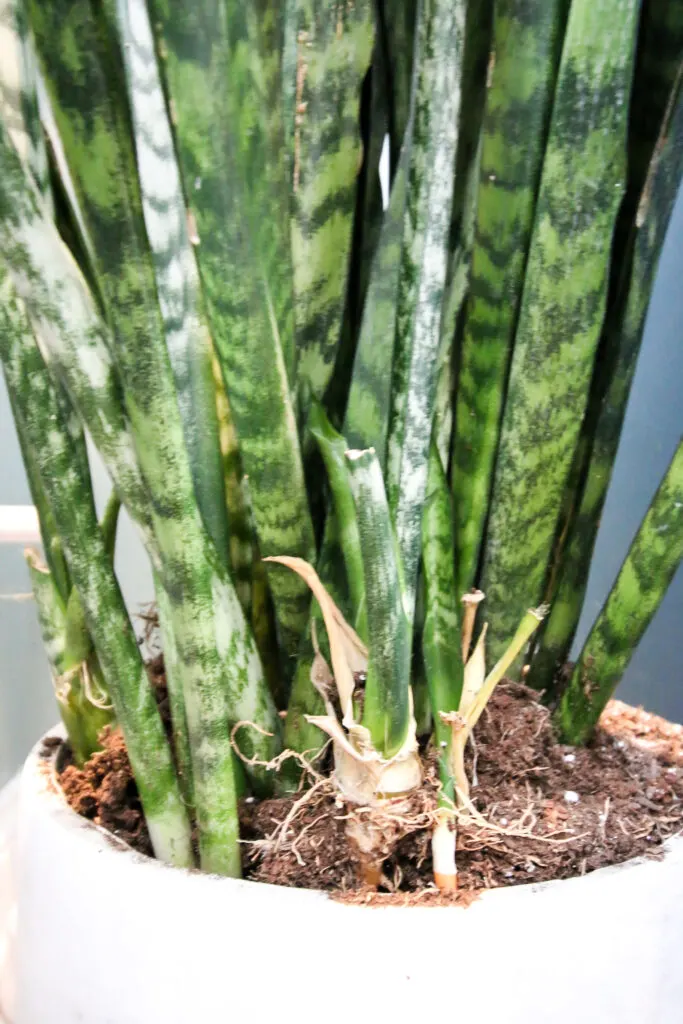Looking for an easy beginner house plant? Snake Plant is perfect for you! Here is a complete Snake Plant care guide for beginner level plant owners!
There are a few houseplants that are really marketed towards beginners. My personal favorite is pothos, but snake plant is a close second.
Snake plant is low maintenance and has really beautiful long leaves that grow upward for a dramatic look.
Snake plant (sansevieria) is also known as the Mother in Law’s Tongue plant. I don’t know why but this name really makes me laugh!
Snake plants have gotten the reputation of being really low-light, low-water plants, meaning that they do OK if neglected.
While this is true, they won’t really thrive unless they have access to water and at least some indirect light!
Let’s talk about snake plant care tips and how to help your snake plants thrive!

Varieties of Snake Plants
Snake plants come in a lot of varieties! Some of the most common include:
- Black Gold
- Futura Robusta
- Twisted Sister
- Laurentii
- Cleopatra
- Ceylon Bowstring Hemp
- Cylindrica
Do snake plants need a lot of sun?
Snake plants don’t need a lot of sun. They can actually tolerate very low light conditions. But, they grow best with bright, indirect light.
How big do snake plants grow?
Different varieties of snake plants can grow to different sizes, some reaching as tall at 7 feet! These are slow growers so that would take a long time.
Where should I place a snake plant in my house?
Place your snake plant beside a sunny window if you really want it to grow and flourish. If you are OK with it staying the same, place it up to 6 feet from a window.
Avoid vents or windows with drafts. These plants do not want to be blown on by the heat or air conditioning!
Snake plant benefits
It is said that Snake plants help to remove toxins Trichloroethylene (TCE), Benzene, and Formaldehyde from the air. I’m honestly not sure how true that really is, but it is a nice thought.
Are snake plants toxic?
Snake plants can be poisonous if ingested. Keep away from children and pets!
Can snake plants grow outdoors?
Snake plants can definitely grow outdoors in indirect light. They can get sunburned out in the direct sun. Just be sure to bring your sansevieria plant indoors if the overnight temperature will drop below fifty degrees!

How do you take care of an indoor snake plant?
How often do you water a snake plant?
Snake plants have underground bulbs called rhizomes. They retain water like a camel’s hump. So, they don’t need to be watered too often. Soggy plants will rot.
Instead, only water your plant every 2 to 8 weeks when the soil has completely dried out. Always be sure that your pot has drainage holes to avoid excess water pooling, which will lead to root rot.
Should I mist my snake plant?
NO do not mist a snake plant. they tend to have water pool on the leaves, and then they rot. Just don’t do it!
What are snake plant’s lighting needs?
There is a lot said about snake plant light requirements. Some plant brands seem to want to say you can be growing snake plants in a dark windowless closet. So, do snake plants need light, for real?!
Snake plants do best with bright indirect light. They will grow the most and flourish this way. These plants can be tolerant of low light conditions, but they will not grow much or at all without light.
If you plan to put a snake plant in a low light spot, look for one with dark green leaves. The varieties with darker leaves are said to do better in low light situations! Lighter leaves and variegated leaves really need that indirect sunlight!
What kind of soil does a snake plant need?
Snake plants need well draining soil because they are sensitive to over watering. You can use potting mix, but the best snake plant soil is actually a 50/50 mix of cactus/succulent soil and potting mix. That will be well draining and they will be happy!
What is the best pot for a snake plant?
Snake plants actually do great if they are a little root-bound so there’s no need to frequently repot them. They do well in terra cotta pots.

Why are my snake plant leaves turning yellow?
Yellow, limp leaves almost always indicate overwatering in a snake plant. Let it dry out a while before watering again. If it’s severe, you can remove it from it’s pot, wash off the soil, and repot.
Read my complete guide to why your snake plant has brown tips!
Why are my snake plant leaves droopy?
Droopy leaves mean either too much water or not enough light. Feel the soil. If it’s wet, let it dry out. If it’s not wet, then move it to a sunnier location.
Snake plant propagation
Snake plants can be easily propagated with a leaf cutting. I’ve actually done this with leaves that broke off my mama plant!
Let the leaf set until the cut/broken end has dried and calloused over. Then, set in soil and allow it to grow roots naturally! Pretty cool!
Snake plants can also be propagated by division. Remove the pot from the plant and separate the plant at the root. Then, plant in separate pots. Easy!
More snake plant goodness!
- Snake plant care guide
- Sansevieria Fernwood care guide
- How to propagate snake plants
- Why is my snake plant getting brown tips?
- Why is my snake plant turning yellow?
- Why is my snake plant drooping?
Free printable snake plant care guide!
Join the (free!) KeepYourPlantsAlive+ community to access this exclusive printable plant care guide! Once you sign up, you can right click & save the JPG care guide. Or keep scrolling for more!

Any more questions about how to take care of a snake plant?
Thanks for reading!


Hey there, I’m Morgan, a houseplant enthusiast from sunny Charleston, South Carolina. Growing up surrounded by my mom’s lush orchids and African violets, I discovered the magic of bringing nature indoors. Thanks to the pandemic, I delved deeper into houseplants, discovering their power to uplift moods and transform spaces. I’m here to spill all my secrets, helping you pick the perfect houseplant – and make it happy. Let’s keep your plants alive, together! 😊
